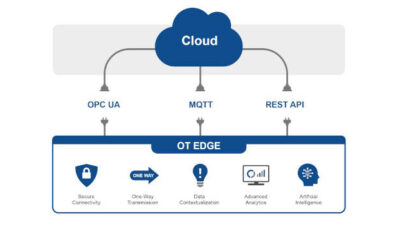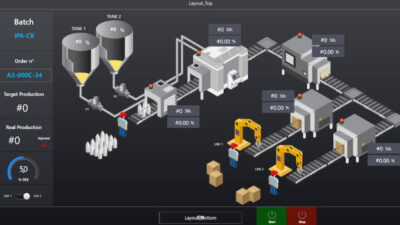In his 1985 book, Competitive Advantage, Michael Porter introduced the concept of the value chain. The premise is that people and processes add value at every step of the product life cycle—from procurement of raw materials to order fulfillment—to the extent that each step is optimized. As such, the final value added is greater than the sum of the steps.
In his 1985 book, Competitive Advantage , Michael Porter introduced the concept of the value chain. The premise is that people and processes add value at every step of the product life cycle—from procurement of raw materials to order fulfillment—to the extent that each step is optimized. As such, the final value added is greater than the sum of the steps.
Over the years, Porter’s ideas evolved into a dictum that businesses can achieve profitability by getting the “right product to the right people at the right time.” But this goal must operate in parallel with the more fundamental strategy that says “sell more and cut costs.”
With a major shift of U.S.-based manufacturing offshore, and the pervasiveness of the Internet to support e-commerce, manufacturers today must be able to compete within a value chain that is at the same time a global supply chain.
In this scenario, inbound logistics, demand management, order fulfillment, manufacturing flow management, supplier relationship management, and reverse logistics all take on entirely new dimensions. The ownership of the underlying data and transactions that support these processes is more widely distributed, making integration of people, processes, and information more complex and important than ever.
The challenge is that technology has changed the rules of engagement, enabling more manufacturers and suppliers to participate in the global supply chain. Competitive advantage goes to companies that focus resources on core competencies and products with strong differentiation, while finding ways to reduce supply chain costs.
More of everything
Manufacturers and suppliers have for years invested in infrastructure and in-house expertise for electronic data interchange (EDI) to support trading relationships—primarily the exchange of orders and invoices with key customers—or they get by with just the basics from a service bureau.
Today, a new delivery model—Software-as-a-Service (SaaS) for EDI—can provide a service-based solution for middle-market suppliers and manufacturers to meet complex and ever-changing requirements mandated by their large trading partners.
Many trading partners are requesting that suppliers synchronize product information according to global standards and provide advance shipping notices accompanied by bar-code labels and RFID tags. Product and shipping information aren’t the only elements of increasing complexity. The “big box” store phenomenon and the Internet spawned new models of consumer behavior that, in turn, have resulted in new supply chain processes that must be supported by manufacturers.
For example, suppliers of consumer packaged goods to big box retailers must support three types of order processing and fulfillment:
Product to distribution centers;
Product direct to stores (Wal-Mart has more than 5,000 ship locations); and
Internet-based orders shipped directly to the consumer.
In addition, many retailers know they can shift costs back to the manufacturer for “special order” products, where the manufacturer holds the inventory and ships directly to consumer upon receipt of an order.
Finally, over the last few years, suppliers and manufacturers have cut costs by shutting down internal manufacturing and warehouse operations and shifting to offshore manufacturing and third-party logistics providers.
However, it also costs money to adhere to global standards for product descriptions, share information with remote manufacturing and warehouse facilities, and link processes and transactions in a global supply chain. The infrastructure and expertise needed often aren’t fully understood. As a result, companies underestimate the total cost of ownership (TCO) of managing these processes.
Sell more with SaaS
SaaS is gaining popularity as an alternative to maintaining certain kinds of functionality and systems internally. Essentially it involves software developed as a Web-native application and delivered as a service over the Internet. Customers don’t purchase and implement this software, but rather pay to use its functionality. Without large initial investment or complex maintenance, a user experiences greater benefits than with licensed software operated on-premise.
SaaS works well in areas where best practices already are in place, and where new functionality may be needed, such as ERP, messaging, and customer relationship management.
One of the big attractions to SaaS is reduced cost. The Software and Information Industry Association estimates the annual cost to own and manage software applications can be up to four times initial cost. Industry analysts like Stamford, Conn.-based Gartner and Framingham, Mass.-based IDC have published research that shows 70 percent to 75 percent of annual IT budgets are allocated to the maintenance of existing systems.
Computing the TCO
Admittedly, it can be challenging to compare total cost of ownership for SaaS versus on-premise solutions because the comparison cannot be exact. This is especially true when assessing costs for EDI and global data synchronization (GDS), as they cross the boundaries of multiple business processes and solutions with varying degrees of integration needed to support the order-to-cash life cycle.
One way to evaluate and compare TCO is to examine resource requirements for infrastructure and professional services for the start-up/deployment phase, as well as ongoing requirements.
The hallmark of a comprehensive SaaS solution for EDI and GDS should be “out of the box” integration with ERP. The SaaS solution must combine a true service architecture and a high degree of software standardization with strong vertical specialization. These components allow manufacturers and suppliers to implement full transaction support with trading partners in a matter of a few weeks versus the usual six to nine months it takes to implement an on-premise system with the same level of functionality.
Pricing models can vary, but usually the customer pays a one-time, modest configuration fee and going forward, pays only for the transactions processed—an “on-demand” variable expense. The ongoing fees may be either by subscription or transaction, or some combination of both.
It is clear that one of the most important benefits of SaaS is the rapid implementation times and resulting acceleration of ROI for the customer. By incorporating global standards for managing EDI and global data synchronization requirements into a single interface, SaaS solutions comprise an ideal architecture for companies of all sizes.
SaaS-based applications also allow companies to stay ahead of the curve to meet the ever-changing supply chain market requirements and industry initiatives necessary to compete successfully in today’s global economy.
Implementation
Ongoing
Start-up infrastructure
Deployment professional services
Infrastructure
Professional services
On-Premise
5-25%
5-15%
5-15%
50-85%
Hardware
Design
Hardware repair/replace
Scheduled maintenance
Software
Configure
Network security bandwidth
Unscheduled maintenance
Security
Integrate
Software maintenance
System monitoring
Network
Test and tune
Redundancy/capacity
End-user support
Monitoring/Management tools
Launch
Added functionality
IT staff training
Facilities
IT staff training
Help desk
Admin. reporting/cost allocation
End-user training
Planning, engineering, testing
Deploy upgrades
Security
Marketing awareness and adoption
SaaS
2-5%
3-5%
80-90%
5-10%
Set-up fees
App testing in desktop environment
SaaS service fee (includes all of above)
End-user management;
API configuration
Usage analysis and cost allocation;
Launch
Vendor interface
End-user awareness
Key benefits of successful SaaS implementations
1. Faster implementation accelerates recognition of ROI by two to four times.
For many organizations, initial cost is not so much a deterrent as having the right resources available for a new initiative. Generally, Software-as-a-Service (SaaS) applications are easily configured to user requirements and deliver as much functionality as users require. This can be a huge advantage for fast-growing companies wherein speed-to-market advantage would be lost if all systems had to be built from the ground up. The same argument can be made for a large enterprise that needs new functionality, or to fill in gaps in an existing in-house application.
2. Fewer IT resources needed to implement, operate, and maintainsystems.
Today hardware and software aren’t considered strategic assets, but rather commodities. There are no initial licensing fees for SaaS, so entry cost is low. There are recurring revenue fees based on number of user seats, subscriptions, or transactions. SaaS providers can maintain and update their network-based, standardized applications efficiently, which in turn reduces the requirements of internal IT staff.
3. Supports unique business processes or compliance for selective product categories or channels.
Business processes and data derived from workflows and customer information are critically important in the global supply chain. SaaS providers have deep domain expertise in the service-based applications they develop and provide. Any SaaS solution should be designed to integrate and support key business processes. A supplier’s key customers—i.e., trading partners—will dictate the business rules, and it’s up to the supplier to put the underlying business process and required infrastructure in place. For example, a large customer may want to order by its own “stock-keeping unit,” while another may use UPC code, while a third may want to use a VAN for communication, and a final example requires AS2 connectivity. A trading partner may require that suppliers send products ordered at its Web site direct to the end user, while stocking orders sent to stores follow yet a different process. SaaS applications that support these multiple business processes eliminate the need for extra infrastructure and provide a supplier with one-to-many business processes that meet the requirements of all of its trading partners.
4. Flexibility to increase/decrease capacity quickly or facilitate migration to new systems.
With SaaS, companies “pay only for what they use.” In accounting terms, this allows organizations to convert fixed costs to variable expenses. For growing businesses, SaaS provides virtual unlimited capacity, enabling them to react quickly to market opportunities. SaaS can keep mission-critical functions going without interruption during major system upgrades or new implementations of core systems, and it can serve as an interim solution as legacy systems or business acquisitions are integrated. SaaS applications are the ideal solution to support B2B collaboration between suppliers and key customers. Fast implementation, the ability to support multiple business processes of trading partners that change over time, strong vertical functionality, and incorporation of best practices all serve to enhance business process integration, and reduce costs for the supplier.
The business case for SaaS : 5 ways it creates value for EDI and data synchronization
Faster implementation can accelerate the recognition of ROI by 2-4 times
Fewer IT resources are needed to implement, operate, and maintain
Can support unique business processes or compliance for selective product categories or channels
Flexibility to increase/decrease capacity quickly or facilitate migration to new systems
Promotes better trading partner relationships
Rise of the humble VAN
With the rise of Internet-based EDI through AS2 or XML technology, it might be safe to assume that traditional Value Added Network (VAN)-based EDI—such as that offered by Sterling Commerce—would be experiencing a decline. Why pay for something that the Internet effectively offers for free?
Because “free” often turns out to be more expensive, says Phil Smith, Sterling’s VP and general manager of products and marketing. “We’re seeing a lot of customers come back to us and say: We thought we would be saving money—but we’re not,” he reports. “Included in the traditional VAN package is a lot of support and customer or supplier ‘onboarding’ that isn’t available in the AS2 world. Especially for small suppliers and customers without a deep bench of IT resource, not only is a VAN inherently simpler, it’s also more cost-effective to onboard and support.”
Consequently, Smith explains, there’s something of a two-tier hybrid world emerging. The AS2 route offers companies the ability to interchange a rich seam of data with their major trading partners. For the 20 percent of customers or suppliers that make up 80 percent of the trade, says Smith, AS2 is the way to go. For the remaining 80 percent of trading partners, though, the traditional VAN is the better bet.
Companies like St. Petersburg, Fla.-based electronics manufacturer Jabil Circuit and Columbus, Ind.-based vehicle engine manufacturer Cummins certainly think so, says Smith. Jabil Circuit, for example, interfaces with more than 5,000 trading partners through Sterling’s VAN. Some 50 partners, however, have special needs—prompting a combination of direct links that include AS2, but also embrace XML, flat-file, Excel, and SAP iDocs formats.
And the proof of the pudding is in the interfacing. VAN traffic through Sterling’s network is growing at 20 percent a year, says Smith, fuelled by new trading partners, richer and more character-intensive documents, and more frequent transmissions.
Services associated with SaaS-based EDI applications
Implementation
Software client installation and configuration
EDI relationship setup with each trading partner
Data synchronization
Transaction mapping for each trading partner
Bidirectional transaction validation
Bidirectional transaction testing
Out-of-the-box data integration with accounting/ERP system, WMS
Label testing and validation
End-user training
Ongoing
EDI standards upgrades
Transaction-set upgrades
IT infrastructure maintenance
Software maintenance and upgrades
Implementation of additional transaction sets
Communications management (VAN, AS2, FTP) throughout the supply chain
Upgrades to accounting/business system
Creation of ASNs and UCC-128 labels
Label printer communications
Label requirement changes from trading partners
Error checking and correction
Live support available to trading partners, suppliers
Back-up and history/audit trail in two distinct and separate locations



